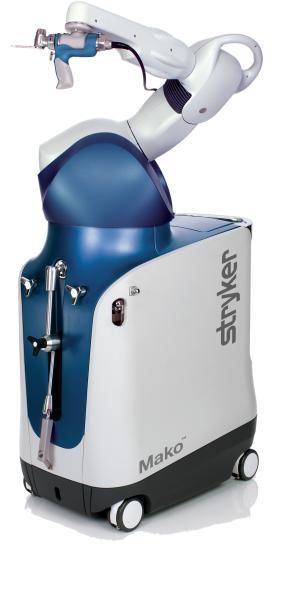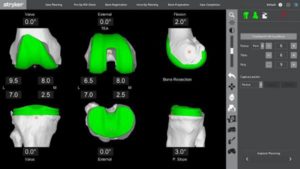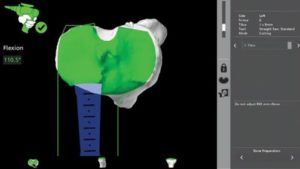 Total knee replacement constitutes two-thirds of all lower extremity joint replacement in the United States. Mako robotic assisted surgery was introduced in 2007 for partial knee replacement and in 2011 for total hip and October 2016 total knee replacement. The technology is a major improvement in accuracy and precision in bone perpetration and implant positioning.
Total knee replacement constitutes two-thirds of all lower extremity joint replacement in the United States. Mako robotic assisted surgery was introduced in 2007 for partial knee replacement and in 2011 for total hip and October 2016 total knee replacement. The technology is a major improvement in accuracy and precision in bone perpetration and implant positioning.
Mako robotic assisted total knee replacement overcomes limitations in instrumentation design and the human imprecision in implementing the preoperative plan. It allows us to execute the desired plan to within one degree for each patient.
A surgeon’s tool
When you hear ‘robotic-arm assisted technology,’ it’s important to understand that the Mako robotic arm doesn’t actually perform the surgery. The surgery is performed by the orthopedic surgeon, who uses the Mako System software to pre-plan the patient’s surgery.
The surgeon guides the Mako robotic arm to remove diseased bone and cartilage and then inserts the total knee implant. The Mako technology was designed to help surgeons provide patients with a personalized surgical experience based on their specific diagnosis and anatomy.
Here’s how it works:
Step 1- Before surgery
It begins with a CT scan of the patient’s knee joint that is used to generate a 3-D virtual model of the patient’s unique anatomy. This virtual model is loaded into the Mako system software and is used by the surgeon to create the patient’s personalized pre-operative plan.
Step 2 – In the operating room
In the operating room, as the bone is prepared for the implant, the surgeon guides the robotic-arm within the area defined in the patient’s pre-operative plan. The Mako system helps the surgeon stay within the planned boundaries. This protects any soft tissue from unintentional injury. The Mako system also allows the surgeon to make adjustments to the plan during surgery, as needed.
Step 3 – After surgery
After surgery, the surgeon, nurses and physical therapists will set goals for the patient according to post-operative total knee replacement protocols. They will also closely monitor patient’s condition and progress.
Ultimately, the Mako total knee replacement represents an exciting technological advance that helps precisely execute the preoperative plan and will hopefully result in higher rates of patient satisfaction.
Mako vs. manual
In a recent study comparing Mako robotic-assisted total knee replacement versus traditional manual total knee replacement, Mako demonstrated on average cuts that were four times more accurate and implant placement that was three times more accurate.







 Joseph M. Ajdinovich, M.D.
Joseph M. Ajdinovich, M.D. Jeffrey T. Alwine, D.O.
Jeffrey T. Alwine, D.O. Shariff K. Bishai, M.S., D.O.
Shariff K. Bishai, M.S., D.O. Peter B. Blank, D.O.
Peter B. Blank, D.O. David B. Dickerson, M.D.
David B. Dickerson, M.D. Albert S.M. Dunn, D.O.
Albert S.M. Dunn, D.O. Eric D. Fornari MD
Eric D. Fornari MD Monet A. France, M.D.
Monet A. France, M.D. Mary Ann Gardner, M.D., Lieutenant Commander, Medical Corp, USNR
Mary Ann Gardner, M.D., Lieutenant Commander, Medical Corp, USNR Michael J. Kaplan, MD
Michael J. Kaplan, MD Harish Kempegowda, M.D.
Harish Kempegowda, M.D.  Bradley J. Lawson, M.D.
Bradley J. Lawson, M.D. Sheryl L. Lipnick, D.O.
Sheryl L. Lipnick, D.O. Timothy A. Luke, M.D.
Timothy A. Luke, M.D. Marc J. Philippon, MD
Marc J. Philippon, MD Pedro A. Piza, M.D.
Pedro A. Piza, M.D. Kevin D. Plancher, MD, MPH
Kevin D. Plancher, MD, MPH Alberto R. Rivera-Rosado, M.D.
Alberto R. Rivera-Rosado, M.D. William I. Sterett, MD
William I. Sterett, MD William W. Stewart, M.D.
William W. Stewart, M.D. Francesca M. Swartz, D.O.
Francesca M. Swartz, D.O. Seth R. Miller, MD
Seth R. Miller, MD Paul M. Sethi, MD
Paul M. Sethi, MD  William D. Murrell, MD
William D. Murrell, MD Tyler J. Brolin MD
Tyler J. Brolin MD Thomas B. Evely, DO
Thomas B. Evely, DO Clifford Voigt, MD
Clifford Voigt, MD Karthikeyan Chinnakkannu, MD
Karthikeyan Chinnakkannu, MD Erik Carlson, MD
Erik Carlson, MD Marc S. Kowalsky, MD
Marc S. Kowalsky, MD  Rachel M. Frank, MD
Rachel M. Frank, MD Max N. Seiter, MD
Max N. Seiter, MD Demetris Delos, MD
Demetris Delos, MD Armando F. Vidal, MD
Armando F. Vidal, MD Lauren M. Fabian, MD
Lauren M. Fabian, MD R. Tim Greene, MD
R. Tim Greene, MD Peter J. Millett, MD, MSc
Peter J. Millett, MD, MSc Jaya Shanmugam, M.D.
Jaya Shanmugam, M.D.